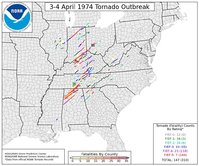Fred Gossage
EF1
Mr. Corfidi and some other cool folks have a new study out concerning this historic event... and the synoptic and sub-synoptic features that made this outbreak what it was.
http://www.spc.noaa.gov/publications/corfidi/74superoutbreak.pdf
Supplemental slide show:
http://www.spc.noaa.gov/publications/corfidi/74apr3_slides/index.html
This study goes a long way in showing just how much we can't take computer model output at face value, even the very advanced, high resolution output we have today. Just because a model has the grid resolution to handle convective structure doesn't mean it's correct. The models did, however, do a decent job at predicting the larger synoptic scale features of the setup... although there were problems with having the surface low too deep and too slow. This study shows us why it's SO important to have a handle on the mesoscale features of a setup to know what it's capable of, but also how dangerous it is to blow off an outbreak with a good synoptic signal... just because our fancy high-resolution models that are capable of doing "future radar" don't model what you'd expect to happen with such a system. It is ultimately the synoptic scale features that drive the evolution of the smaller scale processes that make or break an event. The atmosphere is fluid; everything is connected. Nothing in the "real world" is actually separated by the thresholds that man has created to quantify such features.
http://www.spc.noaa.gov/publications/corfidi/74superoutbreak.pdf
Supplemental slide show:
http://www.spc.noaa.gov/publications/corfidi/74apr3_slides/index.html
This study goes a long way in showing just how much we can't take computer model output at face value, even the very advanced, high resolution output we have today. Just because a model has the grid resolution to handle convective structure doesn't mean it's correct. The models did, however, do a decent job at predicting the larger synoptic scale features of the setup... although there were problems with having the surface low too deep and too slow. This study shows us why it's SO important to have a handle on the mesoscale features of a setup to know what it's capable of, but also how dangerous it is to blow off an outbreak with a good synoptic signal... just because our fancy high-resolution models that are capable of doing "future radar" don't model what you'd expect to happen with such a system. It is ultimately the synoptic scale features that drive the evolution of the smaller scale processes that make or break an event. The atmosphere is fluid; everything is connected. Nothing in the "real world" is actually separated by the thresholds that man has created to quantify such features.


